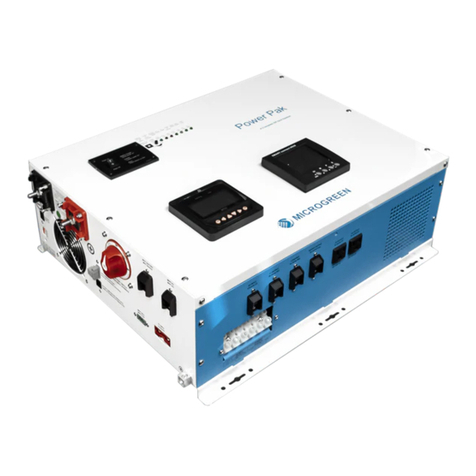Main System
Operational Section
Push the Power Pak switch “ ON” ( push it down)to activate the unit. See fi g 1
Once the unit has gone through its initial power up routine a green LED will turn on to show the unit is ready
and operating ( LED is on the front panel beside the power ON switch ( see Figure 1)
The front panel AC meter should come on, after 5 seconds and show an A C output voltage of around 120 AC
volts. Should it not come on, verify the AC output breaker, located on the bottom of the Power Pak is in the ON
position.
This Power Pak has a 120/240 split phase AC output. This means there is a L1and L2 output with a neutral.
Two- line voltages of 120 AC on the AC meter will appear.
This AC meter will show your instantaneous watts( what is actually operating at that moment) being consumed
and the total watts used over a period of time,(IE: a weekend). This meter allows you toreset the total Kw/hr
reading.C h e c k t h e appendix of th e Power Pak manual on how to reset the total Kw reading.
To understand how much power is available to use, check the following information., In a 24-volt system, using
4-12 volt Batteries, two in series and 4 in parallel@ 105 amp/hr, means2 batteries groupswill be (105 times2
times 24 V, equals about 5000 watts) You would have about 2500 watts of usable power ( 50% of the batteries
total). IF you have 4 – 6 volt @ 400 amp/hr batteries, the power available is as follows. 400 times 24 volts
equals 9600 watts, ( 50% of this will be 4800 watts of usable power)
Therefore, based on how many watts you may consume on a weekend, will s h o w , if t h e battery bank ise n o u g h .
When considering on whether to use 12 volt or 6 volt batteries, keep in mind to amount of power you may
want eventually. If you choose 12 volt batteries, the maximum amount of power you can connect is 5 groups of
100 amp/hr or 24 times 500 equals 12,000 watts of power of which 50% is usable.
If you chose 6 volt, you can have 5 groups of 4-6 volt batteries or 50,000 watts available with 50% usable.
You can not mix 12 volt and 6 volt batteries.
Verify the status of your batteries,by re ading their value first thing in the morning. The battery is a current
device; therefore, your voltage swing in the battery is from 24 volts to 25.6 for 50% of the batte ry’s capacity.
Any number above 25.6 is an arbitrary number as a result after the charging cycle.
When you check the voltage level first thing in the morning before the sun has hit the panels and no major load
is operating, you can see present status. Determ ine the level of your batteries by the voltage level.
( 24 volts is 50 %, 24.8 is 75 % and 25.6 is 100 %.) after charging orrestingovernight.
If you check the voltage level during the day, it will be misleadingv a l u e , due to the solar power coming in, and
power being drawn out.
Since you are actively using power during the day, the voltage level does not properly represent to true value of
the batteries. If you checked the voltage level just after you had vacuumed, the level would be artificially low.
You just removed a lot of current out of the batteries, so they will appear low. Give t h em 10 minutes and check



























